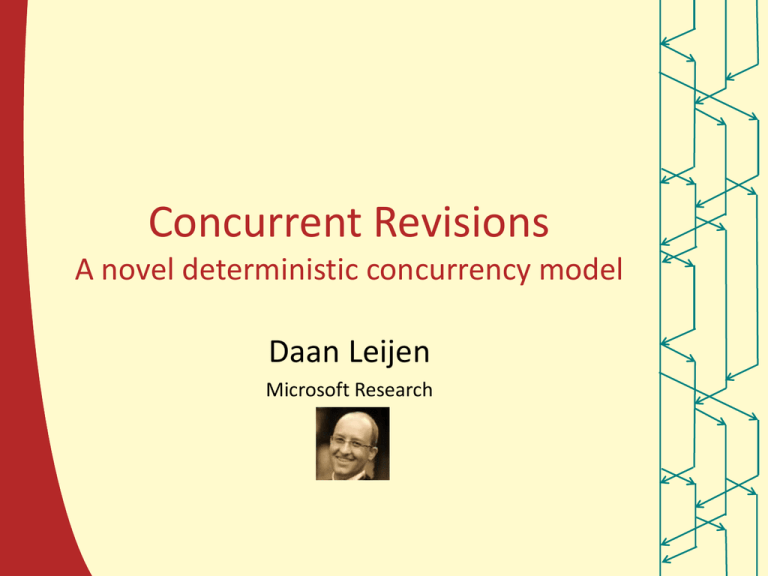x==1
advertisement

Concurrent Revisions
A novel deterministic concurrency model
Daan Leijen
Microsoft Research
Side effects and TPL
• TPL is great for introducing parallelism where
the tasks are independent: i.e. their side
effects are disjoint.
• For example, for matrix multiplication:
int size;
int[,] result,m1,m2;
Parallel.For( 0, size, delegate(int i) {
for (int j = 0; j < size; j++) {
result[i, j] = 0;
for (int k = 0; k < size; k++) {
result[i, j] += m1[i, k] * m2[k, j];
}
}
});
Side effects and TPL
• But it is easy to make mistakes and introduce
data races:
int x,y;
int sum = 0;
Task t = fork {
sum += x;
}
sum += y;
join t;
• We would like to guarantee that sum==x+y but
without fences/locks we could get different
answers
Puzzler
• Suppose we have a sequentially consistent
memory model. What are the values that we
can observe for x and y?
int x = 0;
int y = 0;
Task t = fork {
if (x==0) y++;
}
if (y==0) x++;
join t;
Answer
• Depending on the schedule:
first do task (1) then (2)
: (x==0 && y==1)
or the other way around
: (x==1 && y==0)
or do the test “if (x==0) …” in task (1) first, switch
to the task (2), and increment x, then switch back
to (1) again and increment y : (x==1 && y==1)
int x = 0;
int y = 0;
Task t = fork {
if (x==0) y++;
}
if (y==0) x++;
join t;
(1)
(2)
Do locks or STM help?
• With locks or software transactional memory
we can denote statements that should be
executed atomically.
• What values can we get now for x and y?
x = 0;
y = 0;
task t = fork {
atomic { if (x==0) y++; }
}
atomic { if (y==0) x++; }
join t;
Answer
• Depending on the schedule:
first do task (1) then (2)
: (x==0 && y==1)
or the other way around
: (x==1 && y==0)
but no other schedule is possible
• Still, there is non-determinism introduced by
the scheduler.
x = 0;
y = 0;
task t = fork {
atomic { if (x==0) y++; }
}
atomic { if (y==0) x++; }
join t;
Huge problem in practice
• For many applications we have
large shared data structures
the updates in tasks are dynamic and can conflict
complex invariants that could span over lots of
code
3 Examples of this Pattern:
Office
Parallel
Spellcheck
Browser
Paginate
Parallel
Layout
Render
RRRR
R R R R
Parallel
Physics
Autosave
RRRR
User
Save
Game
Document
DOM
Display
Compute
User Edit
Formulas
Save
Animation
Javascript
Sound
World
Control
NetRender
work
Parallel
Physics
Autosave
RRRR
Sound
World
Control
NetRender
work
The Game:
Can you parallelize this loop?
Conflicts on object
Coordinates:
Reads and writes all positions
Reads all, Writes some positions
Writes some positions
Reads all positions
Reads all positions
Parallelization Challenges
Example 1: read-write conflict
Render task reads position of all game objects
Physics task updates position of all game objects
=> Render task needs to see consistent snapshot
Example 2: write-write conflict
Physics task updates position of all game objects
Network task updates position of some objects
=> Network has priority over physics updates
Conventional Concurrency Control
Conflicting tasks can not efficiently execute in parallel.
pessimistic concurrency control (locks)
• use locks to avoid parallelism where
there are (real or potential) conflicts
optimistic concurrency control (STM)
• speculate on absence of true conflicts
rollback if there are real conflicts
either way: true conflicts kill parallel performance.
Concurrent revisions
• A deterministic and concurrent programming
model
• Apply ‘source control’ on program state
The model:
• Programmer forks & joins revisions (eg. tasks)
• Each revision gets its own logical copy of the
shared state and works fully isolated
• On the join, all changes in a child are merged
into the main revision.
The Programming Model
Main Revision
• Revision shared memory
a = fork {…};
b = fork {…};
Revision a
Revision b
join a;
join b;
Program explicitly forks/joins
revisions
Revisions are isolated: operate
on their own copy of the state
Revisions can be scheduled for
parallel execution
At time of join, conflicts are
resolved deterministically
(always, never roll back)
• Deterministic Semantics
How does it look?
Traditional Task
int x = 0;
Task t = fork {
x = 1;
}
assert(x==0 || x==1);
join t;
assert(x==1);
fork revision:
forks off a private copy of
the shared state
Concurrent Revisions
Versioned<int> x = 0;
Revision r = rfork {
x = 1;
}
assert(x==0);
join r;
assert(x==1);
join revision:
waits for the revision to
terminate and writes back
changes into the main revision
isolation:
Concurrent modifications
are not seen by others
Sequential Consistency
int x = 0;
int y = 0;
Task t = fork {
if (x==0) y++;
}
if (y==0) x++;
join t;
Transactional Memory
int x = 0;
int y = 0;
Task t = fork {
atomic { if (x==0) y++; }
}
atomic { if (y==0) x++; }
join t;
assert(
(x==0 && y==1)
|| (x==1 && y==0)
|| (x==1 && y==1));
assert(
(x==0 && y==1)
|| (x==1 && y==0));
Puzzler: What are x and y for concurrent revisions?
Versioned<int> x = 0;
Versioned<int> y = 0;
Revision r = rfork {
if (x==0) y++;
}
if (y==0) x++;
join r;
Answer:
• In concurrent revision, you can always reason
within one revision as if you are sequential
(since there is full isolation). Therefore, both
revisions (tasks) will increment: x==1 and y==1
• The answer is always independent of any
particular schedule*
Versioned<int> x = 0;
Versioned<int> y = 0;
Revision r = rfork {
if (x==0) y++;
}
if (y==0) x++;
join r;
*) only if deterministic actions are executed
Revision Diagrams ≠ SP-graphs, DAGs
join b;
• Revision
Diagrams are
semi-lattices
join a;
b = fork {…};
Revision b
c = fork {…};
Revision c
• Not as general
as arbitrary
task graphs
c = fork {…};
a = fork {…};
Revision a
b = fork {…};
Revision b
join a;
• Not limited to
“fork-join”
parallelism
Main Revision
Revision a
Main Revision
a = fork {…};
join b; NOT POSSIBLE!
(since b is not visible)
Conflict Resolution: By Type
• Declare Isolation Type
per var/field/struct.
• Two categories:
Versioned<int> x = 0; CumulativeInt x = 0;
x+=3
Versioned Types
• Last join wins
• Good for controlling
write order
Cumulative Types
x==0
x=1
x==1
x==0
x=2
x==2
• Combines effects
• Good for accumulation
• Built-in or User-Defined
x+=1
x==4 x+=2
x==5
x==1
x==4
x==2
x==6
Custom merge functions
merge(main,join,orig)
= main + (join – orig)
CumulativeInt x = 0;
x+=3
x==3
x==0
x+=1
x+=2
x==4
merge(0,4,0)
= 0+(4-0)
x==4
merge(4,5,3)
= 4+(5-3)
x==6
x==5
Back to the Game:
Can we now parallelize this loop?
Conflicts on object
Coordinates:
Reads and writes all positions
Reads all, Writes some positions
Writes some positions
Reads all positions
Reads all positions
autosave
(long running)
network
Physics
Render
part 3
part 4
Collision Detection
part 2
part 1
Revision Diagram of Parallelized Game Loop
autosave
(long running)
network
Physics
Render
part 3
part 4
Collision Detection
part 2
part 1
Isolation Eliminates Read-Write Conflicts
Render task sees stable snapshot
autosave
(long running)
network
Physics
Render
part 3
part 4
Collision Detection
part 2
part 1
Joins Order Write-Write Conflicts
Network after CD after Physics
Overhead:
How much does all the copying and the indirection cost?
Results
Autosave now perfectly unnoticeable in background
Overall Speed-Up:
3.03x on four-core
(almost completely limited by graphics card)
A Software engineering perspective
• Transactional memory:
Code centric: put “atomic” in the code
Granularity:
• too broad: too many conflicts and no parallel
speedup
• too small: potential races and incorrect code
• Concurrent revisions:
Data centric: put annotations on the data
Granularity: group data that have mutual
constraints together, i.e. if (x + y > 0) should hold,
then x and y should be versioned together.
Current Implementation: C# library
• For each versioned object, maintain multiple
copies
Map revision ids to versions
`mostly’ lock-free array
Revision
Value
1
0
40
2
45
7
• New copies are allocated lazily
Don’t copy on fork… copy on first write after fork
• Old copies are released on join
No space leak
Demo
class Sample
{
[Versioned]
int i = 0;
public void Run()
{
var t1 = CurrentRevision.Fork(() => {
i += 1;
});
var t2 = CurrentRevision.Fork(() => {
i += 2;
});
i+=3;
CurrentRevision.Join(t1);
CurrentRevision.Join(t2);
Console.WriteLine("i = " + i);
}
}
Demo
class Sample {
[Versioned,MergeWith(“merge”)]
int i = 0;
public int merge(int main, int join, int org){
return main+(join-org);
}
public void Run() {
var t1 = CurrentRevision.Fork(() => {
i += 1;
});
var t2 = CurrentRevision.Fork(() => {
i += 2;
});
i+=3;
CurrentRevision.Join(t1);
CurrentRevision.Join(t2);
Console.WriteLine("i = " + i);
}
}
Demo: Sandbox
class Sandbox
{
[Versioned]
int i = 0;
Fork a revision without forking
an associated task/thread
public void Run()
{
var r = CurrentRevision.Branch("FlakyCode");
try {
r.Run(() =>
Run code in a certain revision
{
i = 1;
throw new Exception("Oops");
});
CurrentRevision.Merge(r);
}
Merge changes in a
catch {
revision into the main one
CurrentRevision.Abandon(r);
}
Console.WriteLine("\n i = " + i);
}
}
Abandon a revision and don’t
merge its changes.
Formal Semantics
• Similar to the AME calculus by Abadi et al.
• Proof of determinism
• Formal correspondence to the Revision
Diagrams
• Proof of the semi-lattice property
• Can be shown to generalize ‘snapshot isolation’
By construction, there is no
‘global’ state: just local state for
each revision
State is simply a (partial)
function from a location to a
value
Operational
Semantics
For some revision r, with snapshot
and local modifications and an
expression context with hole ( x.e) v
On a join, the writes of the
joinee r’ take priority over
the writes of the current
revision: :: ’
the state is a composition
of the root snapshot
and local modifications
On a fork, the
snapshot of the new
revision r’ is the
current state: ::
Questions?
• daan@microsoft.com
• sburckha@microsoft.com
• Download available soon on CodePlex
• Play right now on the web:
http://rise4fun.com/Revisions
• Bing “Concurrent Revisions”
http://research.microsoft.com/en-us/projects/revisions/





